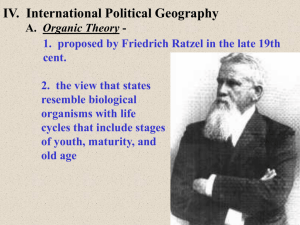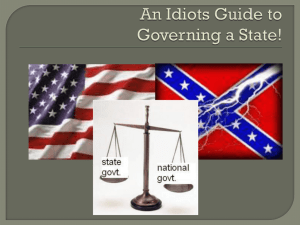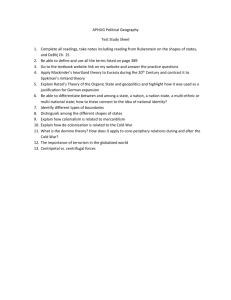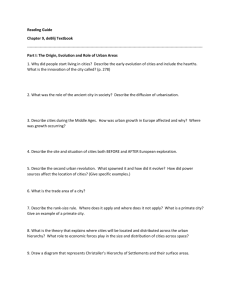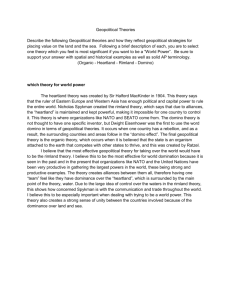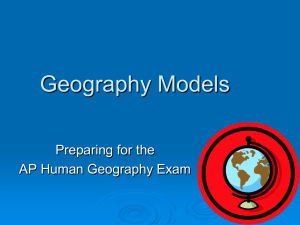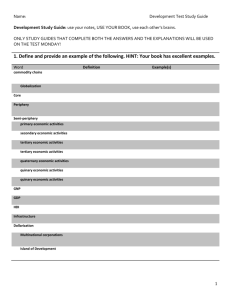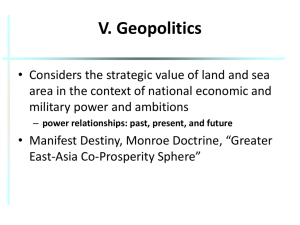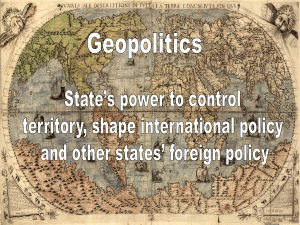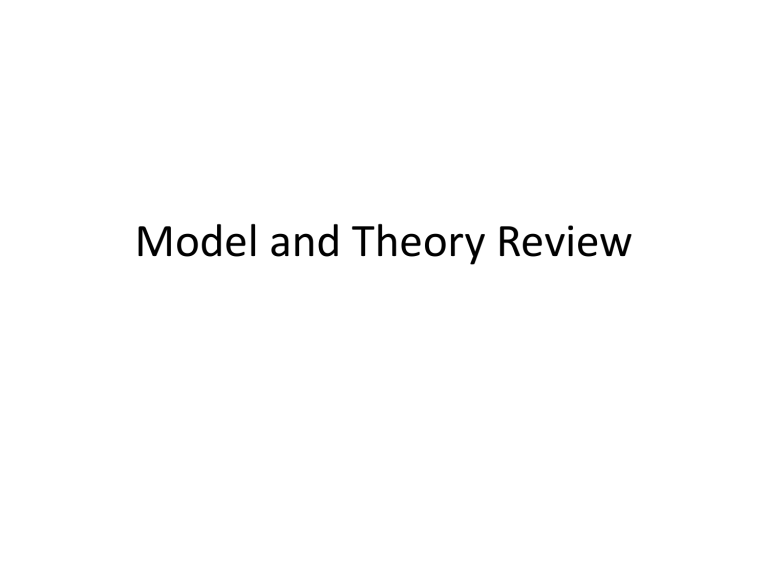
Model and Theory Review Demographic Transition Model Stage 5 - CBR drops below the low CDR leading to population decline. Population Pyramids Epidemiologic Transition Model by Abdel Omran 1. The Age of Pestilence and Famine: Where mortality is high and fluctuating, precluding sustained population growth, with low and variable life expectancy, vacillating between 20 and 40 years. 2. The Age of Receding Pandemics: Where mortality progressively declines, with the rate of decline accelerating as epidemic peaks decrease in frequency. Average life expectancy increases steadily from about 30 to 50 years. Population growth is sustained and begins to be exponential. 3. The Age of Degenerative and Man-Made Diseases: Mortality continues to decline and eventually approaches stability at a relatively low level. Malthusian Theory • Postulated that while food production tends to increase arithmetically, population tends to increase naturally at a (faster) geometric rate. • Hasn’t occurred. Religions Universalizing Ethnic • • • • • • • • • Christianity Islam Buddhism Sikhism Mormonism (a form of Christianity) • Seek converts, proselytize, appeal to all. Holidays based around important figures’ lives. Judaism Hinduism Animism Shinto • Practiced by an ethnic group. Holidays based around calendar events. Religious Hearths Gravity Model Distance Decay Model Heartland Theory -This theory was developed in 1904 by Halford J MacKinder. -His geopolitical theory argued that political power depended on geographical location. More specifically, his theory can be explained with the following sequence: -1) He who rules inland Europe ( “Heartland) à rules Eastern Europe -2) He who rules inland Europe ( “Heartland”) à rules Europe, Asia, and Africa ( “World Island”) -3) He who rules Europe, Asia, Africa ( “World Island”) à rules the World ( “World Domination”) Rimland Theory by Nicholas John Spykman • Spykman thought Rimland, the strip of coastal land that encircles Eurasia, is more important than the central Asian zone (the so-called Heartland) for the control of the Eurasian continent. Spykman's vision is at the base of the "containment politics" put into effect by the United States in its relation/position to the Soviet Union during the post-war period. • According to him, "who controls the Rimland rules Eurasia, Who rules Eurasia contents destinies of the world." Domino Theory • The domino theory was a foreign policy theory during the 1950s to 1980s, promoted at times by the government of the United States, that speculated that if one land in a region came under the influence of communism, then the surrounding countries would follow in a domino effect. The domino effect suggests that some change, small in itself, will cause a similar change nearby, which then will cause another similar change, and so on in linear sequence, by analogy to a falling row of dominoes standing on end. • Led to the development of Vietnam as a shatterbelt between the United States and the Soviet Union. Heartland vs. Rimland Cultural Hearths Agricultural Hearths Animals – Many animals were first domesticated in Mesopotamia and Egypt Agricultural Revolutions • 1st Agricultural Revolution – Neolithic Revolution (12000BCE-4000BCE) roughly – domestication of plants and animals • 2nd Agricultural Revolution –Coincided with Industrial Revolution. After Columbian Exchange. Led to first Commercial Farms. • 3rd Agricultural Revolution (Green Revolution) – Development of more efficient techniques, fertilizers, GM crops, hybrid crops, started with rice. Vonn Thunen Agricultural Model • Developed to determine the most profitable place to grow crops. • 1800s Weber – Model of Industrial Location • Alfred Weber formulated a least cost theory of industrial location which tries to explain and predict the locational pattern of the industry at a macro-scale. It emphasizes that firms seek a site of minimum transport and labour cost. • To determine the best place to put a factory. • Bulk-gaining vs. bulk reducing industries. • Transportation is the most important cost to control. Types of Industry • Primary Industry – Extract materials from the Earth • Secondary Industry – Turn the materials into something else in factories. Build stuff. • Tertiary Industry – Services • Quaternary Industry – The quaternary sector of the economy is a way to describe a knowledge-based part of the economy, which typically includes services such as information technology, information-generation and -sharing, media, and research and development, as well as knowledge-based services like consultation, education, financial planning, blogging, and designing. • Quinary Sector - The quinary sector involves the highest levels of decision making in fields such as government, research, education, healthcare, recreation, and other information-based industries Country Shapes • • • • • Compact – Poland, Uruguay Elongated – Chile, Pakistan Perforated – Italy, South Africa Fragmented – Indonesia, Japan, Philipines Prorupted – Democratic Republic of the Congo, Thailand, Afghanistan, Namibia Compact Elongated Prorupted Fragmented Perforated Central Place Theory – Walter Christaller • (Christaller) is a geographical theory that seeks to explain the number, size and location of human settlements in an urban system. The theory was created by the German geographer Walter Christaller, who asserted that settlements simply functioned as 'central places' providing services to surrounding areas Settlement Size Rank Size Rule • The largest city will be twice as large as the second largest city by population • Three times as large as the third largest city by population. • Four times as large as the fourth largest city by population. • And so forth • So if the largest city has 10 million people, the size would decrease from • 10 million5 million3.3 million 2.5 million 2 million Primate City Model • One city is far and away larger than all of the others in a country • IE: Bangkok Thailand, Mexico City, Mexico • Paris, France Concentric Zone (Burgess Model) Model ie: Nashville Tennessee (Burgess) Based on human ecology theories done by Burgess and applied on Chicago, it was the first to give the explanation of distribution of social groups within urban areas. This concentric ring model depicts urban land use in concentric rings: the Central Business District (or CBD) was in the middle of the model, and the city expanded in rings with different land uses. It is effectively an urban version of Von Thunen's regional land use model developed a century earlier. It contrasts with Homer Hoyt's sector model and the multiple nuclei model. Sector Model ie: Chicago is a model of urban land use proposed in 1939 by economist Homer Hoyt. It is a modification of the concentric zone model of city development. The benefits of the application of this model include the fact it allows for an outward progression of growth. Multiple Nuclei Model (ie: NYC, Atlanta, LA) an ecological model put forth by Chauncy Harris and Edward Ullman in the 1945 article "The Nature of Cities." The model describes the layout of a city. It notes that while a city may have started with a central business district, similar industries with common landuse and financial requirements are established near each other. These groupings influence their immediate neighborhood. Hotels and restaurants spring up around airports, for example. The number and kinds of nuclei mark a city's growth. Latin American City Model The Southeast Asian City Model The Sub-saharan Africa City Model Industrial Sectors • Primary – extract natural resources (farming, fishing, logging, mining) • Secondary – Construct and build things from natural resources (factories, construction, metal refineries) • Tertiary – Service Sector • Quarternary - knowledge-based part of the economy which typically includes services such as information generation and sharing (intellectual activities) • Quinary – health, culture, research (decision making) Remember the difference The Peripheral Model • According to the peripheral model, an urban area consists of an inner city surrounded by large suburban residential and business areas tied together by a beltway or ring road. • Peripheral areas lack the distinct problems of inner cities but are often segregated and suffer from sprawl. Edge City • Edge cities exist around beltways and ring roads. They are nodes of consumer and business services. • Originated as suburban residences for people who worked in the central city. • Specialized nodes develop in edge cities (office parks, hotels and warehouses near airports.) Urban Realms Model (James Vance) Urban Realms Model Structuralist or Liberal Theories of Development • Structuralist – Believe that inequality exists and that core states exploit the periphery (Since there are winners, there are also losers and all the games are rigged to protect the winners) - Marxist • Liberal – Believe all countries can modernize and become more developed by following the same path. (Everyone can be a winner) Capitalist Rostow Take-Off Model (Modernization Model) –Walt Whitman Rostow (Liberal) • Used to measure levels of development. Modernization Theory (Liberal) • The theory looks at the internal factors of a country while assuming that, with assistance, "traditional" countries can be brought to development in the same manner more developed countries have. Modernization theory attempts to identify the social variables which contribute to social progress and development of societies, and seeks to explain the process of social evolution. Not surprisingly, modernization theory is subject to criticism originating among communist and free-market ideologies, world systems theorists, globalization theory and dependency theory among others. Neocolonialism (Structuralist) • is a term used by post-colonial critics of developed countries' involvement in the developing world. Writings within the theoretical framework of neocolonialism argue that existing or past international economic arrangements created by former colonial powers were or are used to maintain control of their former colonies and dependencies after the colonial independence movements of the post-World War II period. Dependency Theory (Singer and Prebisch) • A structuralist theory that offers a critique of the modernization model of development. Based on the idea that certain types of political and economic relations (especially colonialism) between countries and regions of the world have created arrangements that both control and limit the extent to which regions can develop. Premises of Dependency Theory (Singer and Prebisch) - Structuralist 1. Poor nations provide natural resources, cheap labour, a destination for obsolete technology, and markets for developed nations, without which the latter could not have the standard of living they enjoy. 2. Wealthy nations actively perpetuate a state of dependence by various means. This influence may be multifaceted, involving economics, media control, politics, banking and finance, education, culture, and sport. World Systems Theory (Immanuel Wallerstein) Structuralist • the founder of the intellectual school of worldsystems theory, characterizes the world system as a set of mechanisms which redistributes resources from the periphery to the core. In his terminology, the core is the developed, industrialized part of the world, and the periphery is the "underdeveloped", typically raw materials-exporting, poor part of the world; the market being the means by which the core exploits the periphery. • CoreSemiPeripheryPeriphery Core-Periphery Model • The other name for World Systems Theory. • Core Region - The centers of economic, political, and/or cultural power within a given territorial entity. • Peripheral Region - The least powerful regions and therefore are often marginalized or under the control of both semi-peripheral regions and core regions. • Semi-Peripheral Region - The intermedency regions in terms of the hierarchy of power between core regions and peripheral regions. Core-Periphery Model Bid-Rent Theory • that refers to how the price and demand for real estate changes as the distance from the Central Business District (CBD) decreases. It states that different land users will compete with one another for land close to the city centre. This is based upon the idea that retail establishments wish to maximise their profitability, so they are much more willing to pay more money for land close to the CBD and less for land further away from this area. Zelinksy Model of Migration Transition • Migration trends follow demographic transition stages. People become increasingly mobile as industrialization develops. More industrial migration is seen in stage 2 as migrants search for more space and opportunities in countries in stages 3 and 4. Stage 4 countries show less emigration and more intraregional migration. Ravenstein’s Laws of Migration Ravenstein Continued Locational Interdependence (Hotelling) • Hotelling’s theory of locational interdependence asserts than an industry’s locational choices are heavily influenced by the location of their chief competitors and related industries. In other words, industries do not make isolated decisions on locations without considering where other, related industries exist. Bochert’s Model of Urban Evolution • Bochert created this model in the 1960s to predict and explain the growth of cities in for phases of transportation history. • Stage 1 – “Sail Wagon era of 1790-1830” • Stage 2 – “Iron Horse era of 1830-1970” • Stage 3 – “Steel Rail epoch of 1870-1920” • Stage 4 – “Car and Air Travel 1920-present” Possible Indo-European Language Hearths • Kurgan Hypothesis - Indo-European peoples arrived in the 4th millennium BC across the steppes north of the Black Sea. A warlike people, they imposed themselves as an elite on the Old European populations, who adopted their language. The hypothesis that Indo-European speakers reached Europe from the Pontic steppes in the Bronze Age • Anatolian Hearth Hypothesis - suggests that the speakers of the Proto-Indo-European language (PIE) lived in Anatolia during the Neolithic era, and associates the distribution of historical Indo-European languages with the expansion during the Neolithic revolution during the seventh and sixth millennia BC. Anatolian vs. Kurgan Language Families of the World • Distribution of the world’s main language families. Languages with more than 100 million speakers are named. Major Language Families Percentage of World Population • The percentage of world population speaking each of the main language families. Indo-European and Sino-Tibetan together represent almost 75% of the world’s people. Most Spoken Languages Projections – Mercator Projection Robinson Projection Winkel-Tripel Projection Interrupted Projection Azimuthal Projection Mollweide Projection
